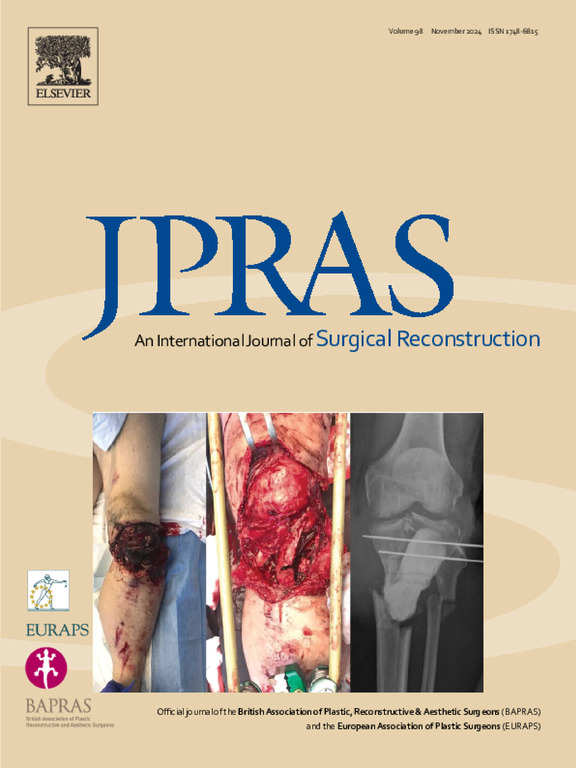Socioeconomic disparities in reception of limb-sparing surgery versus amputation for lower extremity sarcoma
IF 2
3区 医学
Q2 SURGERY
Journal of Plastic Reconstructive and Aesthetic Surgery
Pub Date : 2024-10-11
DOI:10.1016/j.bjps.2024.10.005
引用次数: 0
Abstract
Background
In lower extremity sarcoma treatment, limb salvage approaches present superior alternatives to amputation due to reduced postoperative morbidity and improved quality of life. This study provides a novel analysis of socioeconomic disparities that may affect reception of limb-sparing surgery.
Methods
Patients with lower extremity bone or soft tissue sarcoma who received either limb-sparing surgery or amputation from 2007 to 2021 were identified in the Surveillance, Epidemiology and End Results (SEER) database. Demographic, socioeconomic, and oncologic variables were collected for each patient. Multivariate binary logistic regression was conducted to assess preoperative demographic and oncologic risk factors for amputation (p < 0.05).
Results
A total of 6465 patients were identified in the final cohort, 586 (9.1%) of whom received amputation. After controlling for tumor size, stage, and neoadjuvant therapy administration, non-Hispanic American Indian/Alaskan Native race/ethnicity predicted the highest odds of amputation (OR: 1.78, 95% CI: 1.12–2.85, p = 0.015). Nonmetropolitan residence (OR: 1.69, 95% CI: 1.43–2.00, p < 0.001) also conferred higher risk of amputation compared with residence in a large metropolitan area. Overall, amputation was associated with a higher risk of ten-year cancer-specific mortality (p < 0.001) even when controlled by sociodemographic and clinical characteristics.
Conclusions
There are significant disparities in limb-sparing surgery and amputation rates in lower extremity sarcoma management, even when accounting for differences in baseline oncologic characteristics. Further study into socioeconomic drivers of these trends will allow the development of initiatives that improve disparities in reconstructive outcomes.
接受下肢肉瘤保肢手术与截肢手术的社会经济差异。
背景:在下肢肉瘤治疗中,由于术后发病率降低、生活质量提高,保肢手术是截肢手术的优选方案。本研究对可能影响接受保肢手术的社会经济差异进行了新颖的分析:方法:从监测、流行病学和最终结果(SEER)数据库中筛选出2007年至2021年间接受保肢手术或截肢手术的下肢骨或软组织肉瘤患者。收集了每位患者的人口统计学、社会经济学和肿瘤学变量。进行了多变量二元逻辑回归,以评估截肢的术前人口学和肿瘤学风险因素(P 结果:最终共确定了 6465 名患者,其中 586 人(9.1%)接受了截肢手术。在控制了肿瘤大小、分期和新辅助治疗后,非西班牙裔美国印第安人/阿拉斯加原住民种族/民族预测截肢的几率最高(OR:1.78,95% CI:1.12-2.85,p = 0.015)。非大都市居住地(OR:1.69,95% CI:1.43-2.00,p 结论:肢体截肢的几率存在显著差异:即使考虑到基线肿瘤学特征的差异,在下肢肉瘤治疗的保肢手术和截肢率方面仍存在明显差异。进一步研究这些趋势的社会经济驱动因素将有助于制定改善重建结果差异的措施。
本文章由计算机程序翻译,如有差异,请以英文原文为准。
求助全文
约1分钟内获得全文
求助全文
来源期刊
CiteScore
3.10
自引率
11.10%
发文量
578
审稿时长
3.5 months
期刊介绍:
JPRAS An International Journal of Surgical Reconstruction is one of the world''s leading international journals, covering all the reconstructive and aesthetic aspects of plastic surgery.
The journal presents the latest surgical procedures with audit and outcome studies of new and established techniques in plastic surgery including: cleft lip and palate and other heads and neck surgery, hand surgery, lower limb trauma, burns, skin cancer, breast surgery and aesthetic surgery.

 求助内容:
求助内容: 应助结果提醒方式:
应助结果提醒方式:


